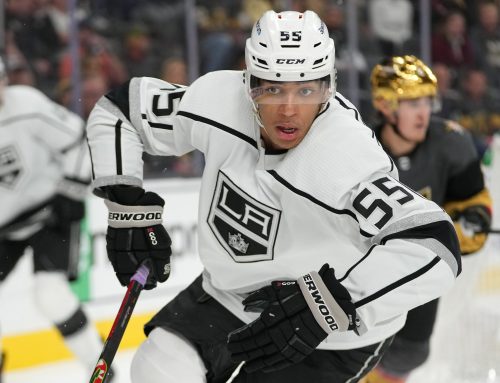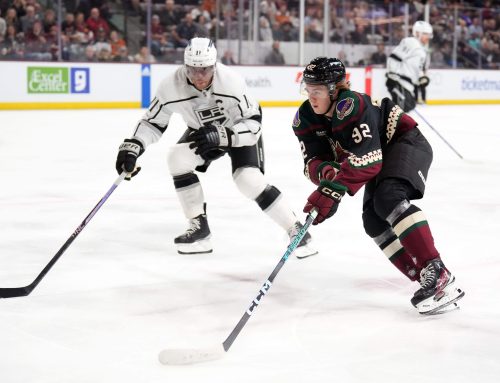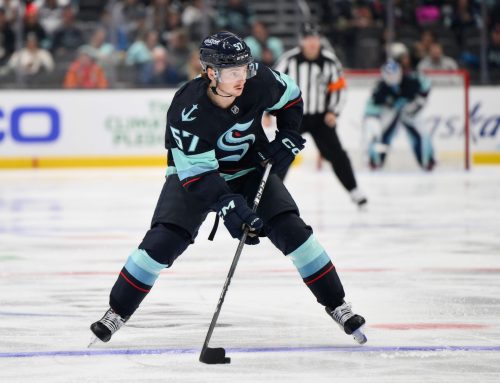The Journey: Revisiting Star Potential in the 2023 Draft Class, Part Two
Ben Gehrels
2024-04-06
Welcome back to The Journey, where we track the development of prospects as they excel in junior, make the NHL, and push towards stardom.
***
Picking up where we left off last week, we will finish revisiting the star potential of the 2023 draft class (top 30) using the Hockey Prospecting model. Even though it is too soon to say anything for sure given the small sample size of a single campaign, there have already been some interesting developments that warrant attention.
Here is the next group, ranked #21-30 in the 2023 class in terms of current Star Potential. The first number is their draft-year Star %, the second is where they stand now, and the parentheses show movement:
Koehn Ziemmer (LAK): 41 → 27 (-14)
Leo Carlsson (ANA): 19 → 25 (+6)
Jiri Felcman (???): 0 → 24 (+24)
Bogdan Konyushkov (???): 11 → 23 (+12)
Ivan Anoshko (???): 22 → 22 (0)
Nick Lardis (CHI): 13 → 20 (+7)
Matthew Wood (NAS): 41 → 20 (-19)
Colby Barlow (WPG): 41 → 20 (-21)
Alexander Rykov (CAR): 13 → 20 (+7)
Carson Rehkopf (SEA): 15 → 20 (+5)
The biggest fallers in the top 20 of this class included:
Zach Benson (BUF): 68 → 43 (-25)
Oliver Moore (CHI): 53 → 37 (-16)
David Reinbacher (MTL): 37 → 27 (-10)
Lukas Dragicevic (SEA): 53 → 44 (-9)
Andrew Cristall (WAS): 59 → 52 (-7)
Mikhail Gulyayev (COL): 84 → 77 (-7)
So Barlow, Wood, and Ziemmer were three of the biggest first-round fallers in this class's Draft+1 campaign. As I stated last week, however, that does not necessarily mean they struggled this year.
Benson remains the biggest faller so far, for instance, but that is likely because the model is measuring his first-year NHL production (34-point pace) against other 18-year-old rookies who previously lit up the WHL. That is an extremely tough jump to make, and the fact that Benson has already made an NHL impact and looked like a star at times puts him at the top of this draft in a very exclusive group with Connor Bedard, Adam Fantilli, and Leo Carlsson, the top three players picked. Jack Hughes (NJD) scored at a 28-point pace at the same age, for reference, although he was a product of the NTDP. So no need to panic in the slightest about Benson's value as a fantasy asset, despite the apparent drop in star potential.
Ziemmer's year was a bit of a write off because he sustained an ankle injury in late November that held him out until March. While he struggled to score upon his brief return (three points in seven games), he kicked off the year with 31 points in 20 games. That is a point-per-game pace of 1.55, which puts him in the neighbourhood of fellow 2023er Carson Rehkopf (SEA, 18), who clicked at 1.58 ppg pace in the OHL and ended up with 95 points. Had Ziemmer stayed healthy and sustained that pace, in other words, he would likely have ended up near the top 30 in CHL scoring (WHL, OHL, and QMJHL combined).
While that sounds impressive enough, an ankle injury of this magnitude for the former third-round pick is concerning, especially given that skating was his main deficiency at the draft. He suffered "torn ligaments and a cracked tibia" when he fell awkwardly to the ice during a fight. I don't know enough to comment on the potential long-term ramifications of such an injury, but while he had an above-average skill set across the board, Elite Prospects rated his skating an abysmal 3.5 (where 5 is NHL average). And that was before the injury.
Our scouts at Dobber Prospects agreed. Here is what Sebastian High (Head of Scouting) wrote in our final rankings: "His defensive engagement is low, his offensive game is typically lacking in tenacity despite his strong physical frame, and his skating clearly projects as sub-NHL average. Adding a few gears to his motor, learning to collect more information in his scans, and improving his explosiveness could unlock the top-six upside his tools give him, but we're a bit skeptical of the likelihood of that happening."
A gnarly ankle injury was definitely moving in the opposite direction from "adding a few gears to his motor." That said, he is still only 18 and still has the potential to be a multi cat stud with wicked puck handling and shooting skills combined with a capacity for imposing physical play. He continues to draw my interest in fantasy as a unique asset in this class, but this year definitely raised some red flags.
A bit like legendary Kings' winger Luc Robitaille, Ziemmer will likely not be scoring off the rush too often if he makes it to the show. He lives in front of the net and will more likely be sniping in tight and cleaning up garbage in front.
***
As for Barlow, I covered him a few weeks ago, concluding that "he struggles in transition, doesn’t have great off-puck impacts, and has posted poor playmaking results." Like Ziemmer, Barlow has a chance to become one of the best goal-scoring power forwards in this class, but "my worry is that he is too one-dimensional and may struggle as the quality of competition increases." Hopefully he can take a more decisive step forward in 2024-25.
***
That leads us to Matthew Wood. Taken 15th overall by the Preds, Wood was attractive despite his poor skating because he was the youngest player in the NCAA, has a large frame (6-4, 200 lbs), went basically a point-per-game as a draft-eligible freshman (34 in 35), and—again, like Ziemmer—possessed a deadly tool kit aside from his skating, which EP awarded a score of 4. Lots to like there.
Wood finished at #21 in the DP final rankings. He struck our team as a clear early-to-mid first rounder, but the conclusion was that "his skating and defence, unless improved, will hold him back from being highly effective in an NHL top-six."
Without updated tracking data yet, it is difficult to ascertain his progression in transition and on defence in particular. Offensively, though, it was clearly a tough year for Wood—despite the fact that his 28 points in 35 games led the team. That output represented a six-point drop from a year ago on the same team (UConn), which finished 8th out of 11 teams in the Hockey East division this year, their point total (29) more than doubled by the powerhouse Boston College (61).
Interesting news on that front emerged about a week ago: Wood will be leaving UConn next year, with his destination still uncertain.
The author of that tweet mentions Minnesota as the frontrunner, with Wisconsin and North Dakota in the mix. While it is always uncertain which players will re-up for another year of college, these are all stronger teams and renowned hockey programs. If Minnesota wins out, that could potentially land Wood with Oliver Moore (CHI), Jimmy Snuggerud (STL), Sam Rinzel (CHI), Rhett Pitlick (MTL), and/or Ryan Chesley (WAS)—a strong group of future NHLers who should have a crack at the National Championship. Snuggerud, possibly the best of the bunch, just announced that he will return to Minnesota for his Junior year. This is a situation to continue monitoring over the summer.
For now, my feeling is that Wood remains a "1B" type fantasy prospect—not quite top-tier but not far off either. This next year will go a long way toward determining his NHL future. Age has always been on his side, as he just turned 19 a few months ago, so he has a lot of runway left. Hopefully he lights it up at Minnesota (or elsewhere) next year and reestablishes his trajectory for Nashville.
***
Returning to that #21-30 group, Jiri Felcman came out of nowhere this year. I have never actually seen a prospect go from 0% star potential in his draft year to 24% the following. What an insane jump! After one year in the Swiss junior league, this former third-round pick is right behind Leo Carlsson?

As with Benson's apparent fall, there is much more to the story here—namely that very few NHLers have ever followed Felcman's particular route up through the Swiss U-20-Elit league, so the model has very little to work with by way of historical comparables. He scored 31 points in 40 games there last year, and followed that up with 23 in 26 this year, including brief low-scoring stints in the top-two men's leagues.
Chicago's AHL affiliate announced a couple weeks ago that they were signing Felcman to an Amateur Tryout. If he is unsuccessful, it appears that he will be returning to the same U-20 Swiss league—which, in my opinion, would not bode well for his future NHL success. Like Wood, he is a big guy (6-4, 200 lbs) with decent pedigree. If he can make the Wolves, his status as a fantasy asset should become clearer in a hurry.
While he might warrant a stash in deeper formats, Felcman is mainly a wait-and-see situation for now in my books. His comparables in the HP model—players who came out of more obscure European junior leagues—include Mats Zuccarello, Dainius Zubrus, and a long string of busts. The odds are definitely against him, but this +24 jump in star potential is also definitely intriguing.
***
Two other prospects on this list beside Felcman made me go, "Who???"
Bogdan Konyushkov (MTL) improved 12 points and Ivan Anoshko (Unsigned) stayed level at 22% star potential. Let's bypass Anoshko for now, given that he is unsigned and currently playing in an American league I have never heard of. What immediately catches my eye about Konyushkov is that he is captaining his KHL team at age 21. He was snagged by Montreal in the fourth round last year as an overager and has two solid pro-level seasons under his belt already with decent production from the backend (53 points in 129 games).
Patrick Bexell at Habs Eye on the Prize has an excellent take on Konyushkov's development and potential. Long story short, his game has NHL potential across the board—except for his skating, particularly his balance, which makes it difficult to defend against pro-level forwards.
***
I am actually quite high on Alexander Rykov (CAR) as one of the better under-the-radar options in this draft class. Part of what has kept him out of the fantasy limelight to this point, in my opinion, is that he has been playing above his age group since his draft year instead of piling up points against his peers in the MHL. Another big factor is that he was presumably injured for the second half of his draft-year campaign.
After putting up 22 points in 38 MHL games in his D-1 year, Rykov acquitted himself well as a draft-eligible, scoring 11 points in 20 VHL games and going scoreless (with almost no ice time) in six KHL games. Potentially because of the limited viewings due to his missed time, Rykov fell to Carolina in the fourth round in last year's draft.
But this year, he returned to the VHL and put up an excellent 25 points in 27 games—a pace that tied him for seventh overall in points-per-game. He also saw the ice slightly more often in 29 KHL games this year, collecting eight points while often sitting as a healthy scratch or hitting the ice for a whopping minute and 24 seconds (March 4th against Salavat). Those gains in his development fueled the seven-point jump in star potential to his current 20%.
The main question with Rykov is his ultimate upside. Aside from his NHL-average skating, EP rated all of Rykov's skills at a 5.5 or 6—meaning his tool kit should be good enough to make the show. He finished 54th on the DP draft board (EP had him at 59), with Jordan Harris (Russian Regional/European Crossover Scout) pointing out that, as a draft-eligible, Rykov seemed overwhelmed at first by the pace at the VHL level but soon adjusted and began to shine as a playmaker. Harris also notes that "there's not a ton of creativity to his game. Still, he plays a very intentional game where he usually accomplishes what he sets out to do, even if it doesn't involve a ton of skill."
While concerns about creativity and skill are pretty significant red flags for me in terms of future fantasy value, Rykov still seems like a bit of a sleeper asset at the moment because of his promising production but low profile. As of last year, Harris projected Rykov as having "an honest shot at a third-line role as a competitive energy player who can contribute as a depth scorer." Unlike some of the others profiled this week, Rykov is a strong skater, so at least he has that working in his favour.
Overall, Rykov strikes me a bit like a lower-powered Danila Yurov. He has a balanced skill set with no real holes, and the lack of ice time (and resulting production) in Russia makes his scoring potential tricky to ascertain.
***
Thanks for reading! Follow me on X @beegare for more prospect content and fantasy hockey analysis.





 BOS
BOS TOR
TOR CAR
CAR NYI
NYI WPG
WPG COL
COL VAN
VAN NSH
NSH DAL
DAL T.B
T.B FLA
FLA VGK
VGK PIT
PIT CHI
CHI
